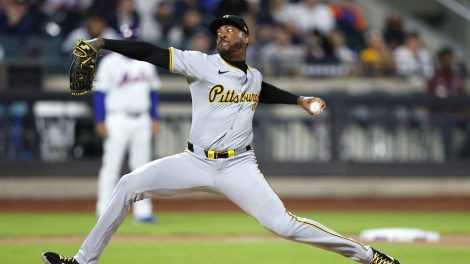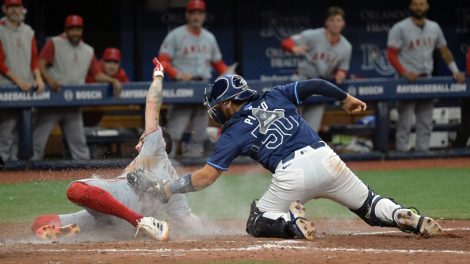TORONTO — The discourse around the Toronto Blue Jays this off-season is sure to be centred around the free agencies of Marcus Semien, Robbie Ray and Steven Matz, and whether or not any or all can be re-signed.
Given how essential they were to the club’s unrewarded 91-win season in 2021, that’s completely understandable. But in the micro question of will they or won’t they be back is also a much more macro question, one whose answer, in large measure, will determine how aggressive the Blue Jays can be in trying to accomplish the former.
And that is, just how high will this club’s payroll eventually go?
That’s the heart of the matter, because the payroll efficiency that’s helped drive the runs to an expanded post-season berth in the pandemic summer of 2020 and this season’s agonizingly near-miss is disappearing. Vladimir Guerrero Jr.’s salary will spike as he enters arbitration for the first time, the same will happen to Bo Bichette next fall, while Teoscar Hernandez is due for a jump his second time through as is Jose Berrios, set for a third turn before hitting free agency.
Hence, sustaining the Blue Jays’ transition from young team on the rise to mature club trying to maintain means the payroll must rise commensurately just to keep the core in place, let alone augment the group.
The need for such a staggered progression is part of the long-term vision Blue Jays president and CEO Mark Shapiro has sold to owner Rogers Communications Inc. (which also owns this website), and he expects, despite two seasons of pandemic upheaval, that plan to remain on track for 2022 and beyond.
“The choreography of our off-season leaves our final payroll meeting with ownership still about a month away. While I like to think I’m making those decisions unilaterally, I’m certainly not. We’ve got to make our proposal,” Shapiro said during a Zoom chat with media Monday. “But every indication I’ve received and every indication that we’ve been shown … leads me to believe that we will stay on plan and the payroll will continue to rise despite the fact that we’re still lagging behind a little bit in revenues due to uncontrollable circumstances.”
That’s important, since typically payroll increases are driven by revenue growth and while the Blue Jays are planning for a normal April next year, the past two years have shown us the peril in taking the containment of COVID-19 for granted.
This year, the Blue Jays spent an estimated $140 million on their major-league payroll, and given all the raises due, bringing everyone back would be far more expensive. They have about $65 million already committed to George Springer, Hyun Jin Ryu, Randal Grichuk and Lourdes Gurriel Jr., while MLB Trade Rumors projects Berrios, Hernandez and Guerrero alone to tack on $28 million more.
Add in other arbitration-eligible players and 0-3 service time players earning near the big-league minimum, and the Blue Jays are into the $110-$115 million range.
Even if Semien and Ray were to struggle on the market and sign very conservative deals at an annual average salary of $20 million, that would push the Blue Jays well beyond last year’s total and that’s without bringing back Matz, augmenting the bullpen, balancing the lineup and building out depth.
Then in 2023, when Bichette first starts getting paid, Guerrero gets even more expensive and Hernandez is making serious coin, the constraints get even tighter. Ryu’s $20 million comes off the books in after ’23, but his innings will need replacing, so as much as the Blue Jays need talent this winter — there’s probably one more big contract in them for this cycle — they also need some financial efficiencies even as their payroll grows.
To that end, worth noting is that the Blue Jays were running payrolls in the $160 million range as recently as 2017-18. Shapiro said that if the current COVID trends hold, he expects the club “to be quickly growing towards those (2015-16 attendance) levels here.”
That’s why, “I feel like we can continue to raise the payroll, as we already have to unprecedented levels, and that our team and our fans and the city and this incredible market, which is a country, can support us continuing to raise it,” said Shapiro.
Whether that’s high enough to carry megadeals for both Guerrero and Bichette, along with an extension for Hernandez, Springer and one or two new impact adds is another matter. The Blue Jays have long valued their financial flexibility and unless they’re going to be a team spending up to the competitive balance tax, currently set at $210 million, they’ll be in a tough spot properly supporting a core group of five or six premium players.
When asked if the Blue Jays could be a team that breaks the threshold, Shapiro said “that’s not something I’ve thought a lot about,” and added that, “I’m not sure with how we’re currently constructed, we’ve got the revenues to support a team that goes over the CBT.”
“We have to determine whether there are revenue sources outside that we have not currently tapped into or mined if we’re going to get into those areas, or a level of proactively deficit spending that our ownership deemed to be a strategic decision,” he added. “But it’s not something that we’re planning for as we sit here and look at the payrolls moving outward.”
[snippet id=5196472]
Maybe a Rogers Centre redevelopment, something put on hold by the pandemic, changes some of that calculus. The dome will have a new scoreboard in 2022, but a wider updating is “a bigger issue that we’ve got to address.” That’s not changing in time for this current core and Shapiro opted not to immediately dive too deeply into the macroeconomic reasons why one of North America’s largest markets can’t make the jump into CBT range when asked.
Either way, the Blue Jays will need to move decisively into baseball’s upper third in payrolls (Spotrac had them 11th this year), CBT crossing or not, to sustain and build on what they already have. So yes, a lot of this off-season is about Semien, Ray and Matz, but it’s really also about a whole lot more.
[relatedlinks]









